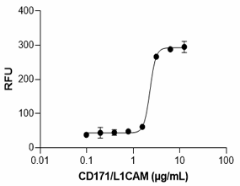- Regulatory Status
- RUO
- Other Names
- antigen identified by monoclonal R1, CAML1, CAML1N-CAML1, CD171 antigen, CD171, L1CAM, MASA, MIC5, N-CAM-L1, NCAML1, neural cell adhesion molecule L1, Cell Adhesion Molecule L1, L1 cell adhesion molecule, S10, SPG1

-

Recombinant Human L1CAM/CD171 supports the adhesion of Neuro-2A mouse neuroblastoma cells in a dose-dependent manner. The ED50 range for this effect is 0.8 - 8 µg/mL. Calcein-AM (Cat. No. 425201) was used to measure the adherent cells. -

Stability testing for recombinant Human L1CAM/CD171. Recombinant Human L1CAM/CD171 was aliquoted in PBS, pH 7.5 at 0.2 mg/mL and one aliquot was kept at 4°C (Control), and another was frozen and thawed four times (4x Freeze/Thaw). The samples were tested by their ability to support the adhesion of Neuro-2A mouse neuroblastoma cells in a dose-dependent manner. The ED50 range for this effect is 0.8 - 8 µg/mL. Calcein-AM (Cat. No. 425201) was used to measure the adherent cells.
| Cat # | Size | Price | Quantity Check Availability | ||
|---|---|---|---|---|---|
| 564804 | 25 µg | $220.00 | |||
| 564806 | 100 µg | $365.00 | |||
Select size of product is eligible for a 40% discount! Promotion valid until December 31, 2024. Exclusions apply. To view full promotion terms and conditions or to contact your local BioLegend representative to receive a quote, visit our webpage.
L1 cell adhesion molecule (L1CAM) is a transmembrane glycoprotein and member of the L1 protein family. It plays a key role in nervous system development, including neuron-neuron adhesion, signal transduction, axon guidance, cell migration and differentiation. It also has a strong implication in treatment-resistant cancers. Mutations in the gene cause three X-linked neurological syndromes known by the acronym CRASH (corpus callosum hypoplasia, retardation, aphasia, spastic paraplegia and hydrocephalus). Alternative splicing of a neuron-specific exon is thought to be functionally relevant. L1CAM binds to number of ligands including homophilic interaction with itself and heterophilic binding to integrin. Furthermore, it binds to other cell adhesion molecules and extracellular matrix molecules; thus, it plays a vital role in cell adhesion and signal transduction.
Product Details
- Source
- Recombinant Human L1CAM/CD171, amino acid Ile20-Glu1120 (Accession No. NM_024003.2) and a C-terminal Fc tag was expressed in 293E cells.
- Molecular Mass
- The 1338 amino acid recombinant protein has a predicted molecular mass of approximately 149.83 kD. The DTT-reduced protein migrates at approximately 210 - 225 kD and non-reduced protein migrates at approximately 250 - 300 kD by SDS-PAGE. The predicted N-terminal amino acid is IIe.
- Purity
- > 95%, as determined by Coomassie stained SDS-PAGE.
- Formulation
- 0.22 µm filtered protein solution is in PBS, pH 7.2
- Endotoxin Level
- Less than 0.1 EU per µg cytokine as determined by the LAL method.
- Concentration
- 25 µg size is bottled at 200 µg/mL. 100 µg size and larger sizes are lot-specific and bottled at the concentration indicated on the vial. To obtain lot-specific concentration and expiration, please enter the lot number in our Certificate of Analysis online tool.
- Storage & Handling
- Unopened vial can be stored between 2°C and 8°C for up to 2 weeks, at -20°C for up to six months, or at -70°C or colder until the expiration date. For maximum results, quick spin vial prior to opening. The protein can be aliquoted and stored at -20°C or colder. Stock solutions can also be prepared at 50 - 100 µg/mL in appropriate sterile buffer, carrier protein such as 0.2 - 1% BSA or HSA can be added when preparing the stock solution. Aliquots can be stored between 2°C and 8°C for up to one week and stored at -20°C or colder for up to 3 months. Avoid repeated freeze/thaw cycles.
- Activity
- ED50 = 0.8 - 8 µg/mL as measured by the ability of immobilized protein to support the adhesion of Neuro-2a cells.
- Application
-
Bioassay
- Application Notes
-
BioLegend carrier-free recombinant proteins provided in liquid format are shipped on blue-ice. Our comparison testing data indicates that when handled and stored as recommended, the liquid format has equal or better stability and shelf-life compared to commercially available lyophilized proteins after reconstitution. Our liquid proteins are validated in-house to maintain activity after shipping on blue ice and are backed by our 100% satisfaction guarantee. If you have any concerns, contact us at tech@biolegend.com.
Antigen Details
- Structure
- It contains several immunoglobulin-like domains and fibronectin-like repeats (type III), linked via a single transmembrane sequence to a conserved cytoplasmic domain.
- Distribution
-
Tetanus-toxin positive neurons, endothelial cells, certain epithelial cells, reticular fibroblasts, colon and breast carcinomas, colon melanoma, tumor cells of neuronal and mesothelial origin
- Function
- Homotypic and heterotypic cell-cell interaction in neuronal myelination, neurite outgrowth, regeneration, axonal guidance, and neuronal migration
- Interaction
- Endothelial cells, epithelial cells, fibroblasts, neurons
- Ligand/Receptor
- Homophilic interaction with itself and heterophilic binding to integrins, other cell adhesion molecules, extracellular matrix molecules
- Bioactivity
- Measured by its ability to support the adhesion of neuro-2a cells
- Cell Type
- Endothelial cells, Epithelial cells, Fibroblasts, Neurons
- Biology Area
- Cancer Biomarkers, Cell Adhesion, Cell Biology, Immunology, Neuroscience, Synaptic Biology
- Molecular Family
- Adhesion Molecules, CD Molecules
- Antigen References
-
- Oswald J, et al. 2021. Mol Ther Methods Clin Dev. 21:180-198.
- Ng PK, et al. 2018. Cancer Cell. 33:450-462.
- Weinberger V, et al. 2019. Front Oncol. 9:265.
- Karnezis AN, et al. 2017. J Pathol Clin Res. 3:279-293.
- Er EE, et al. 2018. Nat Cell Biol. 20:966-978.
- Samatov TR, et al. 2016. Progress in Histochemistry and Cytochemistry. 51:25-32.
- Gene ID
- 3897 View all products for this Gene ID
- UniProt
- View information about L1CAM/CD171 on UniProt.org
